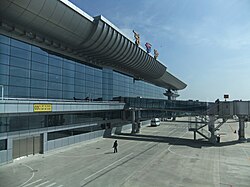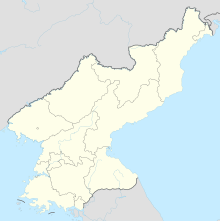Pyongyang International Airport
Pyongyang International Airport 평양 국제비행장 | |||||||||||||||
|---|---|---|---|---|---|---|---|---|---|---|---|---|---|---|---|
 | |||||||||||||||
 Terminal 2 | |||||||||||||||
| Summary | |||||||||||||||
| Airport type | Public | ||||||||||||||
| Owner | Government of North Korea | ||||||||||||||
| Serves | Pyongyang, North Korea | ||||||||||||||
| Location | Ryongbung-ri, Sunan District, Pyongyang, North Korea | ||||||||||||||
| Hub for | Air Koryo | ||||||||||||||
| Elevation AMSL | 34 m / 111 ft | ||||||||||||||
| Coordinates | 39°13′26″N 125°40′12″E / 39.22389°N 125.67000°E | ||||||||||||||
| Map | |||||||||||||||
| Runways | |||||||||||||||
| |||||||||||||||
Sources: U.S. DoD FLIP[1] | |||||||||||||||
| Pyongyang International Airport | |
| Chosŏn'gŭl | |
|---|---|
| Hancha | |
| Revised Romanization | Pyeongyang Gukje Bihaengjang |
| McCune–Reischauer | P'yŏngyang Kukche Pihaengchang |
Pyongyang International Airport (Korean: 평양 국제비행장; Hancha: 平壤國際飛行場; MR: P'yŏngyang Kukche Pihaengchang) (IATA: FNJ, ICAO: ZKPY), also known as the Pyongyang Sunan International Airport,[2] is the main airport serving Pyongyang, the capital of North Korea. It is in the city's Sunan District. The airport was closed to international travel in 2020, because of the COVID-19 pandemic,[3] and reopened in 2023, with the resumption of Air Koryo flights to Beijing and Vladivostok.[4]
History[edit]
Early years[edit]
During the period of Japanese rule, two airports were built in Pyongyang. Pyongyang Air Base was built by the Empire of Japan in the 1940s and remained in use until the 1950s. A second airport, Mirim Airport, was also built by the forces of the empire of Japan in the 1940s, east of the Taedong River. However, after World War II there was a need for a newer airport, and Sunan Airfield was built. Mirim Airport survived as a military airfield, and Pyongyang Air Base was re-developed for government use and for housing.
During the Korean War, the airport was occupied by United Nations forces for seven weeks in late 1950, when the forces flew large amounts of supplies to Sunan. On 13 May 1953, the airport was inundated when the United States Air Force bombed Toksan Dam. After an armistice was signed, two months later, the North Korean Government began repairing and expanding the airport.[5]
The Soviet airline Aeroflot flew to Moscow and Khabarovsk in the 1980s.[6] In the 1990s, Air Koryo also provided nonstop flights to Moscow, which continued on to Berlin and Sofia.[7]
Development since the 2000s[edit]
Russian Sky Airlines operated charter services to Pyongyang from Russian destinations in the mid 2000s on Il-62M and Il-86 aircraft.[8][9][10] China Southern Airlines offered scheduled charter flights to and from Beijing during the peak season only, and permanently stopped its flights in October 2006.[11] In March 2008, Air China re-established service to Beijing on a Boeing 737, three days a week,[12] and suspended due to lack of demand on 22 November 2017.[13] Air Koryo,[14] Korean Air and Asiana Airlines also provided chartered flight services to Seoul and Yangyang, on the east coast of South Korea, from Pyongyang. These flights were used by Koreans visiting relatives across the border; these services were halted after the ending of the Sunshine Policy by South Korea in 2008.[10] In June 2018, Air China resumed service from Beijing Capital Airport to Pyongyang.[15]
By early 2011, an interim facility handling international flights had been built just south of the existing terminal. By early 2012, demolition of the existing terminal, which Kim Jong-un deemed too small and outdated, had begun. In July 2012, he ordered the construction of a new terminal.[16] Besides this, a new control tower and VIP terminal north of the main terminal were also built.[17] The project became part of a "speed campaign", in which thousands of workers were enlisted to complete it quickly.[18] On 15 September 2017, about 6:30am KST, North Korea fired a Hwasong-12 missile from the airport. The missile travelled 3,700 kilometers (2,300 mi) and reached a maximum height of 770 kilometers (480 mi).[19]
Infrastructure[edit]
| External videos | |
|---|---|
Pyongyang International Airport has two passenger terminals. Terminal 1 opened in January 2016 and handles domestic flights only.[20] It is connected to Terminal 2,[20] the international terminal, which was inaugurated on 1 July 2015.[21] Terminal 2 has jet bridges and at least 12 check-in counters.[22][23] Amenities include a duty-free store, coffee bar, newsstand and Internet room,[23][24] along with a snack bar, a pharmacy, a CD/DVD shop, and an electronics shop. There is also a business-class lounge with a buffet on the upper level, along with an outdoor viewing area.
The airport has two functioning runways: one is designated 17/35 and measures 3,425 by 60 metres (11,237 ft × 197 ft),[25][1][26][2][excessive citations] while the other, designated 01/19, measures 4,000 by 60 metres (13,120 ft × 200 ft).[1]
Yonhap reported in September 2016 that a maintenance facility had been built at the Pyongyang airport. About 1 kilometre (0.62 mi) from runway 17/35, the facility includes aircraft hangars and apartment buildings for high-ranking officials and Air Koryo employees.[27]
During the construction period, a hangar-like structure served the airport with basic services (baggage carousel), a duty-free shop, and a bookshop/souvenir shop.[28]
Airlines and destinations[edit]
| Airlines | Destinations |
|---|---|
| Air China[29] | Beijing–Capital |
| Air Koryo[30] | Beijing–Capital, Shenyang, Vladivostok, Wonsan |
Access[edit]
The airport is about 25 kilometres (16 mi) from the city,[31] about 30 minutes' drive by the Pyongyang-Hicheon Expressway.[32] In addition, Sunan Station, on the Pyongui Line of the Korean State Railway, is 800 meters (2,600 ft) from the Pyongyang airport terminal building.[33]
Incidents[edit]
- On February 16, 1958, a Douglas DC-3 of Korean National Airlines was hijacked on a flight from Busan to Seoul by 8 hijackers demanding to be taken to North Korea and landed here. All 34 occupants survived.[34]
- On March 31, 1970, a Boeing 727-89 of JAL (JA8315) was hijacked on a flight from Tokyo to Fukuoka by 9 hijackers demanding to be taken to North Korea and landed here. All 115 occupants survived.[35]
- On August 15, 2006, a Tupolev Tu-154B-2 of Air Koryo (possibly P-561) suffered minor damage in a non-fatal runway mishap on landing from Beijing and was later repaired.[36]
Gallery[edit]
-
The former terminal. (2006)
-
Business Class Lounge
-
Duty-free shop and seats, airside
-
Interior of the current terminal
-
Air Koryo Tupolev Tu-204-300 (P-632) at Pyongyang Sunan's Terminal 2
-
Pyongyang Airport Terminal 2
-
Food store and departures board
-
Inside the former terminal
See also[edit]
References[edit]
- ^ a b c DoD Flight Information Publication (Enroute) – Supplement Pacific, Australasia and Antarctica. St. Louis, Missouri: National Geospatial-Intelligence Agency. 2021. pp. B-271–B-272.
- ^ a b "Pyongyang Intl -- ZKPY". World Aero Data. 2006. Archived from the original on 10 November 2006. Retrieved 2 February 2017.
{{cite web}}: CS1 maint: unfit URL (link) - ^ "Satellite images show 'unusual' level of aircraft maintenance in N. Korea". The Economic Times. 24 May 2023. ISSN 0013-0389. Retrieved 16 July 2023.
- ^ "Air Koryo plane lands in China, first commercial North Korean flight in 3 years". South China Morning Post. 22 August 2023.
- ^ Corfield, Justin (2014). Historical Dictionary of Pyongyang. London, UK and New York, NY: Anthem Press. p.198.
- ^ "1985/86: AEROFLOT Network". Routesonline. 2 March 2011. Archived from the original on 14 August 2016. Retrieved 12 June 2021.
- ^ "Air Koryo timetable". 1998. Retrieved 12 June 2021.
- ^ "✈ russianplanes.net ✈ наша авиация". russianplanes.net.
- ^ "✈ russianplanes.net ✈ наша авиация". russianplanes.net.
- ^ a b Willoughby, Robert (2014). North Korea: The Bradt Travel Guide. Guilford, CT: The Globe Pequot Press Inc. ISBN 978-1-84162-476-1.
- ^ "China Southern to Halt Pyongyang Flights". The Chosun Ilbo via China Aviation Daily. 19 October 2006. Retrieved 29 December 2015.
- ^ Rabinovitch, Simon (31 March 2008). "Air China launches flights to North Korea". Reuters. Retrieved 29 December 2015.
- ^ "Pyongyang flights suspended due to lack of demand". China Daily. Retrieved 23 November 2017.
- ^ "air koryo | 2003 | 2045 | Flight Archive". Flightglobal.com. Retrieved 12 February 2018.
- ^ "Air China resumes Pyongyang service from June 2018". routesonline.com.
- ^ "10 things to know about North Korea's new airport terminal". The Straits Times. 2 July 2015. Retrieved 29 December 2015.
- ^ "North Korea to open new terminal at Pyongyang Sunan International Airport" Archived 23 October 2018 at the Wayback Machine. Airport Technology. 26 June 2015. Retrieved 29 December 2015.
- ^ "North Korea enlists thousands of workers to finish new airport". Associated Press via The Guardian. 22 October 2014. Retrieved 29 December 2015.
- ^ "North Korea 'fires missile from Pyongyang'". BBC. 15 September 2017. Retrieved 15 September 2017.
- ^ a b "Terminal 1 of Pyongyang Sunan Int'l Airport starts operation in DPRK". Xinhua News Agency. 26 February 2016. Archived from the original on 4 March 2016. Retrieved 2 February 2017.
- ^ "With much fanfare, fancy new terminal opens at Pyongyang's international airport". U.S. News & World Report. Associated Press. 1 July 2015. Retrieved 2 February 2017.
- ^ Shim, Elizabeth (2 July 2015). "North Korea: Airport terminal is 'new face' of country". United Press International. Retrieved 2 February 2017.
- ^ a b "10 things to know about North Korea's new airport terminal". The Straits Times. Singapore. 2 July 2015. Retrieved 2 February 2017.
- ^ Talmadge, Eric (27 August 2015). "North Korea's shiny new airport falls short of expectations". The Guardian. Associated Press. Retrieved 2 February 2017.
- ^ "ZKPY – Pyongyang Airport". SkyVector. Retrieved 25 November 2022.
- ^ Corfield, Justin (2013). Historical Dictionary of Pyongyang. London, UK: Anthem Press. p. 198. ISBN 978-0-85728-234-7.
- ^ "N. Korea builds large-scale maintenance complex for Air Koryo planes: report". Yonhap. 1 September 2016. Retrieved 2 February 2017.
- ^ "North Korea races to build new international airport in Pyongyang". Traveller. 24 October 2014.
- ^ {{cite web|url=https://www.flightradar24.com/data/flights/ca563
- ^ "timetable". airkoryo.com.kp. Archived from the original on 21 May 2016. Retrieved 6 June 2018.
- ^ "Map of Sunan-Pyongyang airport". 25 June 2015. Retrieved 18 February 2021.
- ^ The Rough Guide to Korea. Rough Guides. 2015. ISBN 978-0-241-24637-5.
- ^ "平壌~北京間国際列車-平壌→定州". www.2427junction.com. Retrieved 21 June 2017.
- ^ "ASN Aircraft accident Douglas DC-3 registration unknown Pyongyang-Sunan Aiport (FNJ)". aviation-safety.net. Retrieved 31 August 2023.
- ^ "ASN Aircraft accident Boeing 727-89 JA8315 Pyongyang-Sunan Aiport (FNJ)". aviation-safety.net. Retrieved 31 August 2023.
- ^ "ASN Aircraft accident Tupolev Tu-154B-2 P-561 ? Pyongyang-Sunan Aiport (FNJ)". aviation-safety.net. Retrieved 31 August 2023.
External links[edit]
![]() Media related to Sunan International Airport at Wikimedia Commons
Media related to Sunan International Airport at Wikimedia Commons
- 360° virtual tour of the airport – DPRK 360 photography project
- Accident history for FNJ at Aviation Safety Network









